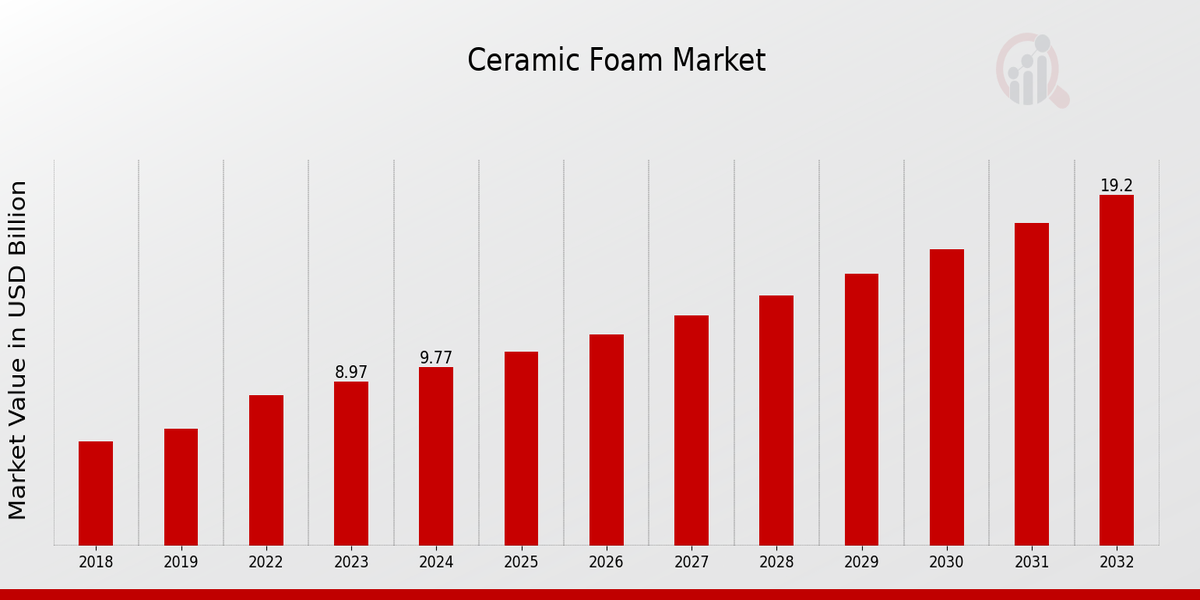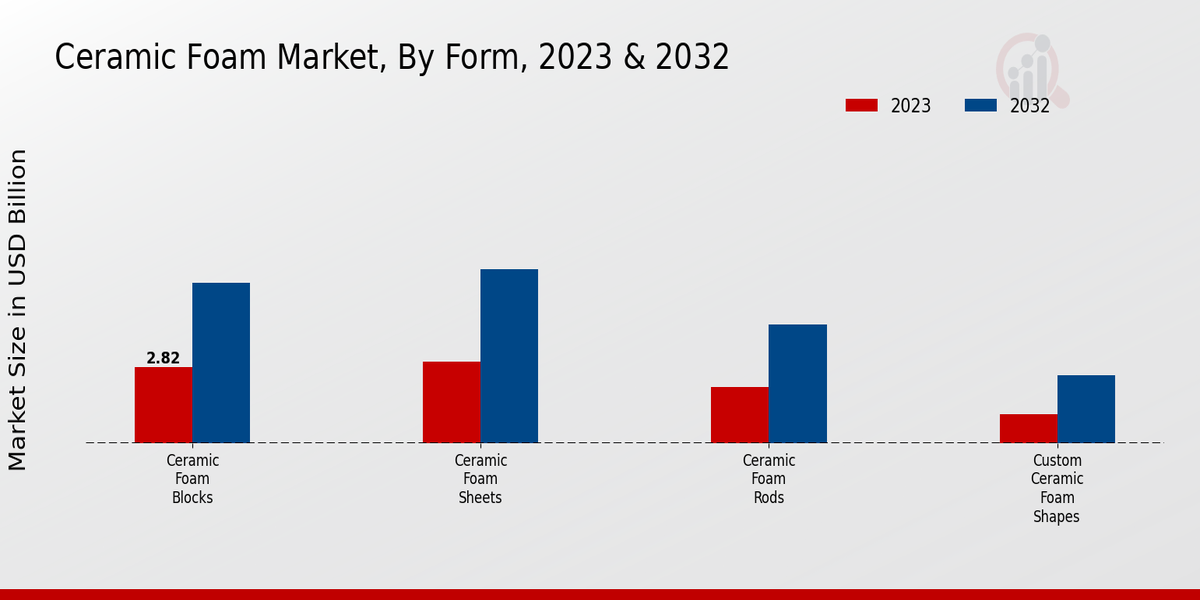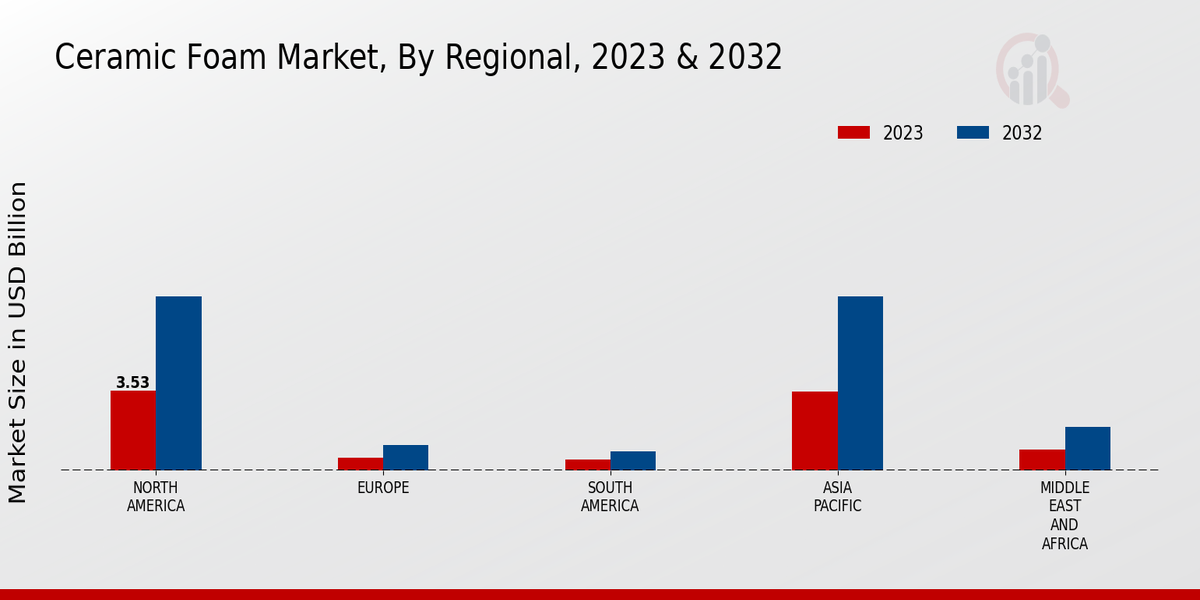Global Ceramic Foam Market Overview
The Ceramic Foam Market Size was estimated at 10.63(USD Billion) in 2024. The Ceramic Foam Industry is expected to grow from 11.57(USD Billion) in 2025 to 24.76(USD Billion) by 2034. The Ceramic Foam Market CAGR (growth rate) is expected to be around 8.80% during the forecast period (2025 - 2034).
Key Ceramic Foam Market Trends Highlighted
Ceramic foam market is primarily driven by increasing demand from various end-use industries such as construction, metallurgy, and aerospace.
Rising urbanization and infrastructure development are fostering the growth of the construction sector, where ceramic foam is used for thermal insulation, lightweight structures, and fire protection.
Additionally, a growing emphasis on energy efficiency and environmental sustainability is driving the adoption of lightweight and high-performance materials like ceramic foam.
Emerging applications in industries such as automotive and electronics offer vast potential for growth. The development of new formulations and manufacturing processes that enhance durability, mechanical properties, and thermal conductivity can lead to increased adoption.
Moreover, advancements in additive manufacturing technologies present opportunities for customization and complex shape fabrication.
Recent trends in the ceramic foam market include increased demand for open-celled foams with superior permeability and thermal conductivity.
The focus on eco-friendly and sustainable materials is driving the development of ceramic foams from recycled or renewable sources.
Furthermore, advancements in 3D printing technology are enabling the production of ceramic foams with intricate designs and improved performance.

Source: Primary Research, Secondary Research, MRFR Database and Analyst Review
Ceramic Foam Market Drivers
-
Rising Demand for Energy-Efficient Building Materials
Ceramic foams have gained significant traction in the construction industry due to their exceptional thermal insulation properties.
As the community becomes increasingly aware of the need for energy conservation and sustainability, the demand for energy-efficient building materials is on the rise.
Ceramic foams offer a unique combination of low thermal conductivity, high porosity, and excellent mechanical strength, making them ideal for use in insulation applications.
They can effectively reduce heat transfer, leading to significant energy savings in buildings, which is a major driver for the growth of the Ceramic Foam Market.
Growing Adoption of Advanced Applications
Ceramic foams are not only used for insulation anymore. Instead, their utilization has been increasing in other industries, such as aerospace, automotive, and biomedical engineering.
In the aerospace industry, ceramic foams are very much used for lightweight structural elements and thermal protection systems due to the excellent thermal stability and the high strength-to-weight ratio.
In the automotive industry, ceramic foams are being used for catalytic and exhaust systems as they have a high surface area and can resist high temperatures.
Moreover, in biomedicine, ceramic foams are useful as biocompatible elements for drug delivery and bone tissue engineering.
Technological Advancements and Product Innovations
The Ceramic Foam Market is growing with the advancement in manufacturing techniques and material science. The researchers are working on innovative ways to enhance the performance and functioning of ceramic foams.
Moreover, they are developing ceramic foams having tailored pore structure, enhanced thermal conductivity, and increased strength that is broadening their applications in the various industries.
The integration of ceramic foams with other materials, including polymers and metals, developing composites with new properties is also increasing their applications.
Ceramic Foam Market Segment Insights
Ceramic Foam Market Form Insights
The Ceramic Foam Market is categorized as Ceramic Foam Blocks, Ceramic Foam Sheets, Ceramic Foam Rods, and Custom Ceramic Foam Shapes.
The Ceramic Foam Blocks segment is expected to dominate the market, generating a significant portion of the Ceramic Foam Market sales in 2023 and will continue to hold its leading position throughout the forecast period.
Ceramic foam blocks are extensively used in construction applications, specifically in the building and infrastructure markets, as they can provide excellent thermal insulating qualities; they are lightweight and can withstand extreme temperatures.
Ceramic Foam Sheets are growing in popularity in the market as they can be easily fabricated and suit various applications and end-use industries.
The market shares of Ceramic Foam Rods are also witnessing solid growth and are used largely in the aerospace and energy markets for high-temperature application requirements.
The Custom Ceramic Foam Shapes segment offers solutions to suit the specific needs of these niche applications.
The increasing prevalence of lightweight and energy-efficient materials and the rapid growth of the construction market will lead to the launch of the Ceramic Foam Market for the next ten years.
With the continuous demand for ceramics used for their insulating and soundproofing applications, businesses will also be able to improve sales due to the use of advanced technologies and access to manufacturing innovations.

Source: Primary Research, Secondary Research, MRFR Database and Analyst Review
Ceramic Foam Market Material Insights
The Ceramic Foam Market is segmented by Material into Alumina Ceramic Foam, Zirconia Ceramic Foam, Mullite Ceramic Foam, and Silicon Carbide Ceramic Foam. Among these, Alumina Ceramic Foam holds the largest market share due to its high strength, thermal stability, and corrosion resistance.
It is widely used in high-temperature applications such as kiln furniture, burner tips, and heat exchangers. Zirconia Ceramic Foam is another popular material, offering excellent thermal insulation and chemical resistance. It is commonly used in aerospace, automotive, and medical applications.
Mullite Ceramic Foam is known for its low thermal conductivity and high-temperature stability, making it suitable for use in thermal insulation, filtration, and catalyst supports. Silicon Carbide Ceramic Foam is gaining traction due to its exceptional wear resistance and high strength.
It is used in filtration, fluidization, and heat treatment applications. The Ceramic Foam Market is expected to grow significantly in the coming years, driven by increasing demand from various industries such as manufacturing, automotive, and aerospace.
The market growth is also attributed to the rising adoption of ceramic foams in energy-efficient and environmentally friendly applications.
Ceramic Foam Market Porosity Insights
Porosity is a key factor in determining the properties and applications of ceramic foam. The porosity of ceramic foam refers to the volume of pores present in the material.
Ceramic foams can be classified into three main types based on their porosity: high porosity (80-90%), medium porosity (60-80%), and low porosity (40-60%). High-porosity ceramic foams are characterized by a high volume of pores, which results in a lightweight and highly porous structure.
These foams have a low density and can be easily compressed. Due to their high porosity, they exhibit excellent thermal insulation properties and are often used in applications where heat transfer is a concern.
Medium porosity ceramic foams have a moderate volume of pores, which results in a balance of properties. These foams are denser than high porosity foams but still have good thermal insulation properties.
They are also more rigid and can withstand higher loads. Medium porosity ceramic foams are used in a wide range of applications, including filtration, catalysis, and sound absorption.
Low-porosity ceramic foams have a low volume of pores, which results in a dense and strong structure. These foams have a high density and can withstand high loads.
They are also more difficult to compress and have lower thermal insulation properties. Low porosity ceramic foams are used in applications where strength and durability are important, such as in structural components and armor.
The ceramic foam market is expected to grow significantly in the coming years. The increasing demand for lightweight and energy-efficient materials is driving the growth of the market.
Ceramic foams are also finding new applications in various industries, including aerospace, automotive, and construction.
Ceramic Foam Market Application Insights
The Ceramic Foam Market is segmented into various applications, including high temperature filtration systems, flow plates in fuel cells, high temperature absorber substrates, and heat shields in aerospace applications.
High-temperature filtration systems use ceramic foam filters to remove particulate matter from hot gases. These filters are used in various industries, including power generation, metal processing, and chemical manufacturing.
The increasing demand for cleaner emissions is driving the growth of the high-temperature filtration systems market.
Ceramic foam flow plates are used in fuel cells to distribute reactants and collect products. The use of ceramic foam flow plates in fuel cells is expected to increase due to the growing demand for clean energy sources.
Ceramic foam high-temperature absorber substrates are used in solar thermal systems to absorb solar radiation and convert it into heat.
The increasing adoption of solar thermal systems is driving the growth of the ceramic foam high-temperature absorber substrates market. Ceramic foam heat shields are used in aerospace applications to protect against high temperatures.
The increasing demand for lightweight and durable materials in aerospace applications is driving the growth of the ceramic foam heat shields market.
Ceramic Foam Market Insights
The Ceramic Foam Market is segmented into various industries, including Aerospace Defense, Energy Power, Automotive, and Chemical Processing.
The Aerospace Defense industry is expected to witness significant growth in the coming years due to the increasing demand for lightweight and durable materials in aircraft and spacecraft.
The Energy Power industry is also expected to contribute to the market growth as ceramic foams are used in high-temperature applications such as thermal insulation and filtration.
The Automotive industry is expected to see increased adoption of ceramic foams for exhaust systems and catalytic converters.
The Chemical Processing industry is expected to use ceramic foams for filtration and separation processes.
Ceramic Foam Market Regional Insights
Regionally, the Ceramic Foam Market is segmented into North America, Europe, APAC, South America, and MEA. In 2023, North America accounted for the largest market share, followed by Europe and APAC.
North America's dominance can be attributed to the presence of major automotive and aerospace industries in the region.
Europe is expected to witness significant growth in the coming years due to increasing demand from the construction and automotive sectors. APAC is projected to be the fastest-growing region, driven by the rising demand from China and India.
South America and MEA are expected to experience moderate growth due to developing economies and increasing urbanization.

Source: Primary Research, Secondary Research, MRFR Database and Analyst Review
Ceramic Foam Market Key Players and Competitive Insights
Key players in the Ceramic Foam Market are focused on improving their product range to meet varied customer requirements. The leading companies operating in the Ceramic Foam Market are investing in research and development activities to improve the efficiency and effectiveness of their products.
The Ceramic Foam Market is poised to grow at a significant pace in the coming years in response to the rising demand for ceramic foams from various end-use industries and government efforts to reduce the environmental impact of manufacturing.
The growing adoption of advanced technologies such as 3D printing and additive manufacturing is also driving the development of the Ceramic Foam Market. The Ceramic Foam Market is a consolidated one that is characterized by the presence of both international and regional players.
One of the leading companies in the Ceramic Foam Market is 3M Company. The company offers a wide range of ceramic foams including high-temperature foam, porous foam, and filtration foam. 3M Company has a strong presence across the globe and operates through its widely established distribution network.
The company is highly oriented to research and development and invests heavily in the development and commercialization of new products and technologies.
Saint-Gobain is another leading company in the Ceramic Foam Market. The company offers a wide variety of ceramic foams including insulation foam, filter foam, and refractory foam.
Saint-Gobain is a concern, meaning that the company has established its presence in several countries across the globe through its sound distribution networks.
The staff of Saint-Gobain are highly oriented towards customer service and the company premise highly on customer satisfaction. Saint-Gobain is an environment-oriented company that invests in research and development activities to reduce the environmental impact of its products.
Key Companies in the Ceramic Foam Market Include
- Saint-Gobain S.A.
- Umicore S.A.
- TDK Corporation
- Morgan Advanced Materials plc
- Entegris, Inc.
- Vesuvius plc
- PQ Corporation
- Almatis GmbH
- 3M Company
- CeramTec GmbH
- CoorsTek, Inc.
- Kyocera Corporation
- Furon Chemical Technical Services Pty Ltd
- Corning Incorporated
- Imery's S.A.
Ceramic Foam Market Developments
The increasing demand for lightweight and thermally insulating materials in various industries, such as aerospace, automotive, and construction, is driving the market growth.
Ceramic foams are gaining popularity due to their exceptional properties, including high strength-to-weight ratio, low thermal conductivity, and resistance to extreme temperatures.
Recent advancements in manufacturing technologies have enabled the production of ceramic foams with tailored properties, further expanding their applications.
Key industry players are focusing on research and development to enhance the performance and cost-effectiveness of ceramic foams, creating new opportunities for market expansion.
Ceramic Foam Market Segmentation Insights
Ceramic Foam Market Form Outlook
- Ceramic Foam Blocks
- Ceramic Foam Sheets
- Ceramic Foam Rods
- Custom Ceramic Foam Shapes
Ceramic Foam Market Material Outlook
- Alumina Ceramic Foam
- Zirconia Ceramic Foam
- Mullite Ceramic Foam
- Silicon Carbide Ceramic Foam
Ceramic Foam Market Porosity Outlook
- High Porosity (80-90%)
- Medium Porosity (60-80%)
- Low Porosity (40-60%)
Ceramic Foam Market Application Outlook
- High-Temperature Filtration Systems
- Flow Plates In Fuel Cells
- High-Temperature Absorber Substrates
- Heat Shields In Aerospace Applications
Ceramic Foam Market Outlook
- Aerospace Defense
- Energy Power
- Automotive
- Chemical Processing
Ceramic Foam Market Regional Outlook
- North America
- Europe
- South America
- Asia Pacific
- Middle East and Africa
| Report Attribute/Metric |
Details |
| Market Size 2024 |
10.63(USD Billion) |
| Market Size 2025 |
11.57(USD Billion) |
| Market Size 2034 |
24.76(USD Billion) |
| Compound Annual Growth Rate (CAGR) |
8.80% (2025 - 2034) |
| Report Coverage |
Revenue Forecast, Competitive Landscape, Growth Factors, and Trends |
| Base Year |
2024 |
| Market Forecast Period |
2025 - 2034 |
| Historical Data |
2020 - 2024 |
| Market Forecast Units |
USD Billion |
| Key Companies Profiled |
Saint-Gobain S.A., Umicore S.A., TDK Corporation, Morgan Advanced Materials plc, Entegris, Inc., Vesuvius plc, PQ Corporation, Almatis GmbH, 3M Company, CeramTec GmbH, CoorsTek, Inc., Kyocera Corporation, Furon Chemical Technical Services Pty Ltd, Corning Incorporated, Imery's S.A. |
| Segments Covered |
Form, Material, Porosity, Application, Industry, Regional |
| Key Market Opportunities |
Advanced catalyst supports High-temperature filtration Metal casting filters Aerospace applications Biomedical materials |
| Key Market Dynamics |
Increasing demand in aerospace and automotive Growing adoption of filtration systems Rise in construction activities Technological advancements Expanding applications in thermal insulation |
| Countries Covered |
North America, Europe, APAC, South America, MEA |
Frequently Asked Questions (FAQ) :
The Ceramic Foam Market size is estimated to be USD 11.57 billion in 2025 and is projected to reach USD 24.76 billion by 2034, exhibiting a CAGR of 8.80% during the forecast period.
Asia-Pacific is expected to dominate the Ceramic Foam Market throughout the forecast period due to the increasing demand from end-use industries such as construction, automotive, and aerospace in the region.
Key growth drivers of the Ceramic Foam Market include rising demand for lightweight and energy-efficient materials, increasing adoption in filtration and catalytic applications, and growing emphasis on sustainability and environmental regulations.
Major applications of Ceramic Foam include filtration (gas and liquid), thermal insulation, catalyst supports, and lightweight structural components.
Key competitors in the Ceramic Foam Market include 3M, Corning Incorporated, Saint-Gobain, and Morgan Advanced Materials.
The Ceramic Foam Market in North America is expected to grow at a CAGR of 7.5% from 2024 to 2032.
Challenges faced by the Ceramic Foam Market include high production costs, limited availability of raw materials, and competition from alternative materials.
Opportunities for growth in the Ceramic Foam Market include increasing demand from emerging economies, technological advancements, and expanding applications in various industries.
Key trends in the Ceramic Foam Market include the development of new and improved manufacturing processes, the integration of advanced technologies, and the increasing use of ceramic foams in sustainable applications.
The Ceramic Foam Market in Europe is projected to reach USD 4.5 billion by 2032, exhibiting a CAGR of 8.2% during the forecast period.

















